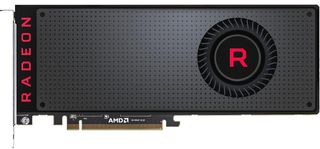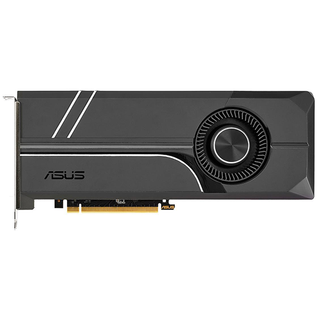Hot Vega: Gigabyte Radeon RX Vega 56 Gaming OC 8G Review
Why you can trust Tom's Hardware
Gaming Performance
We get the feeling that Nvidia's engineers had their hands on a couple of third-party Radeon RX Vega 56 cards when they launched GeForce GTX 1070 Ti. At the very least, they had some inside information. Sure, the 1070 Ti wasn't really meant to be much faster, avoiding cannibalization of GeForce GTX 1080. But Nvidia's card matches up quite well with the various factory-overclocked Vega 56 boards we've already benchmarked.
Comparison Products
Results: 2560x1440 (QHD)
First, we test at 2560x1440, where a card like this is most likely to excel.









In practice, the Radeon RX Vega 56 Gaming OC 8G achieves a 9- to 11%-higher clock rate than AMD's reference card, resulting in average frame rates that are anywhere from 6- to 8% better. That's respectable scaling, to be sure.
Results: 3840x2160 (UHD)









The overall picture doesn't change much at 3840x2160, though there isn't much difference between Gigabyte's card and AMD's reference design. Neither option is ideal for 4K gaming with maxed-out settings. Compromises must be made on the detail sliders to bring frame rates up enough for smooth performance.
Summary
It's hardly possible to match these cards more perfectly. Sometimes the Radeon RX Vega 56 Gaming OC 8G is a bit faster than a GeForce GTX 1070 Ti, and sometimes it's the other way around. Overall, then, it can be hard to tell them apart. Too bad Nvidia seems to have boards for sale, while none of AMD's partners can say the same. An overclocked Radeon RX Vega 56 is quite fast by any standard.
MORE: Best Graphics Cards
MORE: Desktop GPU Performance Hierarchy Table
MORE: All Graphics Content
Stay on the Cutting Edge
Join the experts who read Tom's Hardware for the inside track on enthusiast PC tech news — and have for over 25 years. We'll send breaking news and in-depth reviews of CPUs, GPUs, AI, maker hardware and more straight to your inbox.
-
marcelo_vidal With the pricey from those gpus :) I will get an 2400g and play 720P. maybe with a little tweaking I can boost to 1920x1080Reply -
Sakkura This thing about board partners only getting a few thousand Vega 10 GPUs goes back many months now. Has AMD just not been making any more? What the heck is going on?Reply
Seems like Gigabyte did a really nice job making an affordable yet effective cooling solution for Vega 56, it's really a shame it goes to waste because there just aren't any chips available. -
CaptainTom To those complaining about the low supply (and resulting high prices) of AIB cards:Reply
It's because the reference cards are still selling very well (at least for their supply). If vendors can sell the $500 Vega 64 for $600 and sell out, why would they bother wasting time on any other model? -
g-unit1111 Reply20576533 said:To those complaining about the low supply (and resulting high prices) of AIB cards:
It's because the reference cards are still selling very well (at least for their supply). If vendors can sell the $500 Vega 64 for $600 and sell out, why would they bother wasting time on any other model?
That's because miners are the ones buying the cards as fast as they come in stock. It's us gamers and enthusiasts that are waiting for the high performance models. Bad thing is, we don't matter to the bottom line. All they see and want is our precious money, and they don't care what model they sell to us. -
aelazadne Because, the Vendor's making money doesn't equal AMD making money. AMD is losing market share in the GPU scene. With Vega unable to keep up with demand AMD is losing customers who would have bought Radeon's but instead go with Nvidia due to availability. The lack of Availability stemming from August and the fact that even now in early 2018 the Vegas are over priced and hard to find ruins customer confidence. In fact, this situation is so bad that the only people benefitting are the people gouging both Nvidia cards and Radeon cars because at this point there is NO COMPETITION.Reply
Also, just because you are gouging doesn't mean you are making money. AMD has to make money and they need to sell these things in a certain volume. In their contracts with Vendors, they will require their vendors to sell a certain amount of vegas in order to order more. Due to scarcity the only companies making money are Retailers. AMD is going to have to address this issue otherwise their investors will begin to come after them for bungling so bad that their market share dropped so bag. Literally, the intel screw up plus Ryzen being good has been a godsend for AMD, they do not need a declining GPU market share sparking a debate with investors over whether AMD should get out and play the Intel game. -
bit_user Reply
I really appreciate the thorough review.20575687 said:...
The super-imposed heatpipes vs. GPU picture was a very nice touch. For any of you who missed it, check out page 6 (Cooling & Noise) about 1/3 or 1/2 of the way down.
-
bit_user Reply
I think you're too cynical. It's an ASIC supply problem. The AIB partners would probably spend the time if they could get enough GPUs to sell custom boards in enough volume to offset the overhead of doing the extra design work.20576533 said:It's because the reference cards are still selling very well (at least for their supply). If vendors can sell the $500 Vega 64 for $600 and sell out, why would they bother wasting time on any other model?
The only real way out of this is for AMD to design a more cost-effective chip with the graphics units removed. That will divert miners' interest away from their graphics products. -
bit_user Almost as surprising to me as how much more oomph they got out of Vega 56 is how well the stock Vega 64 is holding up against stock GTX 1080. Is it just me, or did AMD really gain some ground since launch?Reply


